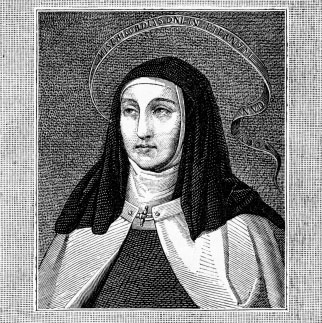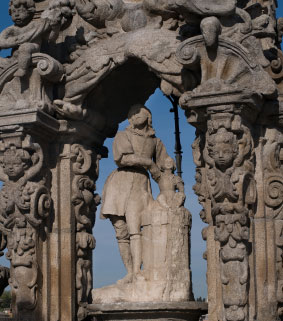"Let nothing disturb you, let nothing frighten you, all things pass away: God never changes." St. Teresa of Avila
Born in Avila, Spain, Teresa was a pretty normal teenage girl. Even before the age of text messaging and malls, her priorities were boys, clothes and flirting, with God taking a backseat to her social activities. Her father thought she was out of control and sent Teresa to a Carmelite convent when she was 16.
Even as a nun, Teresa struggled much of her life with her relationship with God, at one point turning away from prayer completely. In her writings, she sympathized with those who are easily distracted during prayer, like she was. At the age of 41, a priest encouraged Teresa to resume her prayer life. As a result, God blessed her with many mystical gifts, including times of complete quiet and rapture when her body would rise from the ground as she prayed. God also spoke to Teresa, often guiding her in her life.
Often seen as a rebel, Teresa was determined to found her own convent based on the basic contemplative life of poverty devoted to prayer. She founded the Discalced Carmelites.
She died in 1582 at the age of 67 and was canonized in 1622. In 1970 she was named a Doctor of the Church for her writing and teaching on prayer. She is one of only two women to receive this honor. Her writings include “Interior Castle” and “The Way of Perfection.” |
"Abide in peace, banish cares, take no account of all that happens, and you will serve God according to his good pleasure and rest in him."
Born into a poor Spanish family in Avila, Spain, John spent most of his life seeking God. Out of his poverty, he learned to be completely happy in God, joining the Carmelite order to further sacrifice himself for his faith. During this time, St. Teresa of Avila asked John to help her reform the order and bring them back to a life of prayer.
Because some felt threatened by this reform, John was captured by members of his own order, locked in a tiny cell and beaten several times a week by the monks. Within the cell, John had nothing but God, yet called his time in prison the happiest of his life. He spent his time writing of his love for God, and when he managed to escape nine months later, he fled to a convent and read his mystical poetry for the nuns. He died in 1591 at age 49, and was canonized in 1726.
John is known for his writings, including “Spiritual Canticle” and “The Dark Night of the Soul” and is a Doctor of the Church. |
One of Spain’s most popular saints, Isidore was a poor farmer who worked his entire life for a rich land owner in Madrid. He married a young woman who came from a family just as poor as his, and the couple had a son who died as an infant. Still, Isidore and Maria trusted God and believed that their son was happy in heaven.
Isidore began each day with Mass, followed by a day of hard work. While in the fields, he became closer to God than ever before as he often prayed to get through the day’s labor. Many coworkers noticed angels helping Isidore with his work, increasing the farmer’s productivity. Isidore and his wife felt a special calling to help animals and the poor, and it is said that during at least two instances—one while feeding a flock of birds and another while feeding a group of beggars—the small amount of food Isidore had with him multiplied, with more than enough for everyone.
Isidore died at age 60 in 1130. Canonized in 1622, St. Isidore is known as the patron saint of Madrid. His wife, Maria, also was canonized and is known as Santa María de la Cabeza (Saint Mary of the Head), because her saintly remains are often used in processions throughout Spain. |
St. Rose of Lima
Most of us have had days where we wished we looked like someone else or when our vanity was showing. We stare at the mirror, agonizing because our teeth aren’t white enough or trying to will our hair into smooth submission. The first saint of Hispanic origin and one of the patron saints of World Youth Day 2011, St. Rose of Lima had the opposite problem. Given the baptismal name Isabel, Rose was beautiful even as a baby. She was born in 1586 in Peru to parents from Spain. When an infant, a servant said he saw her face transform into a rose. The nickname stuck and eventually became her confirmation name.
But Rose, who is the patroness of Latin America and the Philippines, did not care about her appearance. Her focus was on Jesus. And because she was so afraid someone might be tempted by her beauty or that she would become vane, she cut off her long hair and was known to have rubbed lye and pepper on her face until her complexion was red and blistered.
Rose was from a large family and was dutiful and obedient to her parents, until they asked her to marry. Rose defied her parents by taking a vow of virginity. It is said she fought her parents for 10 years before they finally gave in to her desire.
Rose took penance and prayer to an extreme level. She often wore a metal spiked crown, which she concealed with roses and went days without food. For years, she continued this self-mortification. But God would often reveal Himself to her, flooding her with joy and leaving her in ecstasy for hours. She was often heard to pray, “Lord, increase my sufferings, and with them increase your love in my heart.” Many miracles followed her death in 1617. She was canonized in 1671 by Pope Clement X, the first American to be so honored.
So how can we emulate St. Rose in our daily lives? We probably don’t necessarily need to go around rubbing pepper and lye on our faces or wearing a metal spiked crown. These had been methods she devised from her particular era and place to fight the temptation of vanity. Rose possessed an unwavering focus on God.How often today are we distracted by our looks, by others’ looks? How many times a day do we look in the mirror compared to how many times we talk to God?
As we remember St. Rose, let’s begin to ask God to increase our humility and the desire to cultivate a focused prayer life. Let’s pray to be more like St. Rose—less self-centered and more God-centered. |
St. Rafael Arnáiz Barón
Though he was only 27 when he died, St. Rafael Arnáiz Barón made a significant impact in his short life. Born into a wealthy Spanish family in 1911, Rafael grew up attending Catholic schools. He excelled in both art and spiritual classes and was known as a person with a great sense of humor, energetic joy and deep humility.
When he was 19, Rafael went to Madrid to begin studying architecture. But while there, he discovered his deeper calling. He was attracted to the Trappist (also known as Cistercian) life—drawn by its silent, prayerful beauty. When he was 23, having completed his architectural studies, he entered a monastery.
But Rafael was not able to live his vocation long. Just a few short months after entering the monastery, he became ill with a violent case of diabetes. Throughout his few years at the monastery, Rafael was sick and often forced to rest at home, much to his dismay. Despite his illness, Rafael was said to intensely and purely embody the Cistercian spirit of grace. He died in the monastery’s infirmary at the age of 27, on April 26, 1938.
At World Youth Day in 1989, Pope John Paul II called Rafael a model of holiness for young people, citing his “loving and unconditional response to the divine call.”
Rafael was canonized as a saint by Pope Benedict XVI on Oct. 11, 2009.
Check out his spiritual autobiography called “God Alone” by Gonzalo Maria Fernandez, OCSO. |
St. John of Avila
Though he was born in 1499, St. John of Avila continues to influence spiritual teachings today. St. John was raised in a wealthy family and first felt a call to religious life when he was 14. He studied law as a young man and later focused on theology and philosophy. After his parents died, he sold his fortune and donated the money to the poor.
Ordained in 1525, St. John became a travelling preacher in Andalusia for 40 years, speaking out against the sins of the wealthy ruling class. This earned John a few powerful enemies and he was imprisoned for false teachings in Seville, Spain, by the Inquisition. But the imprisonment only made John’s message grow stronger. He became even more popular and drew great crowds who flocked to hear his message.
St. John also served as a spiritual director to several men and women who went on to become saints themselves, including spiritual director of Saint Teresa of Avila, Saint Francis Borgia, Saint John of God, Saint John of the Cross, Saint Peter of Alcántara, and Saint Louis of Granada. St. John died of natural causes on May 10, 1569. He was canonized by Pope Paul VI on May 31, 1970.
One of the patron saints of World Youth Day 2011, St. John’s writings contain many passages that can be used for reflection by people of all ages:
- Your life consists in drawing nearer to God. To do this you must endeavor to detach yourself from visible things and remember that in a short time they will be taken from you.
- Turn yourself round like a piece of clay and say to the Lord: I am clay, and you, Lord, the potter. Make of me what you will.
- Withdraw your heart from the world before God takes your body from it. |
St. Francis Xavier
During his only 46 years of life, St. Francis Xavier brought tens of thousands of people to Christianity.
Like many Spanish saints, Francis Xavier was born into nobility. He studied and later taught philosophy at the University of Paris. But his good friend, St. Ignatius of Loyola, saw something more in Francis, and brought him into the Catholic faith. Ignatius then encouraged Francis to use his love of God and his talents for teaching and to spread the Gospel. Francis was ordained a priest and became one of the founders of the Jesuits.
He spent his life as a missionary in India, China, Japan and the East Indies. Wherever he went, he lived among the poor, sharing their food and rough accommodations. He spent countless hours ministering to the sick and the poor, particularly to lepers.
It is said that Francis baptized more than 40,000 people during his lifetime, including 10,000 in one month alone. Though he bore some terrible conditions, including extreme heat and cold, he walked thousands of miles—mostly barefoot. And though Francis lived among those with nothing, his letters showed him to be full of joy.
Francis, one of the patron saints of World Youth Day 2011, died Dec. 2, 1552, in China, after contracting a fever. He was canonized March 12, 1622, by Pope Gregory XV. Pope Pius X later named Francis patron saint of all foreign missions. |
St. Ignatius Loyola
“ For not merely among men, but not even among the angels, is there a nobler work than glorifying the Creator and leading His creatures to Him, as far as their capacities permit.”
Do you ever feel like you are searching for something, but you’re not sure what? You have this desire placed on your heart to know Christ, but you’re not sure how to reach Him? This is a tale as old as time. Or at least as old as the time of St. Ignatius of Loyola.
When I think of St. Ignatius, the first thing that comes to mind is Catholic education. Maybe it’s because I have a Marquette t-shirt from my sister that says “a fine Jesuit education since 1881 “ or maybe it’s because there are now 28 Jesuit colleges and universities in the United States alone, but there is much more to be taken from St. Ignatius’ journey besides being the founder of educational institutions.
On my search to learn more about St. Ignatius, I asked my brother what inspires him most about the saint. He put it simply and yet beautifully, “He was just someone who followed his real desire and found its right ends. He tried heroism and it didn’t satisfy. So he tried asceticism. Same. And then he found real, lived, passionate faith.”
St. Ignatius was born Ignacio López de Loyola in today's Basque Country of Gipuzkoa, Spain. The youngest of 13 children, St.Ignatius was only seven years old when his mother died. Soon after he began work as a page. In 1509 St. Ignatius took up arms to fight for his country. He was on his way to military fame when he discovered the Lord had other plans for him. A cannonball shattered St. Ignatius’ leg.
Back in the day before HBO and reality TV, St. Ignatius had nothing better to do during recovery than pick up a few books lying around. The story is told that he had two books to read, one about knights and the other, a book that changed his life forever, De Vita Christi, by Ludolph of Saxony. Ludolph suggests to the reader to place himself at the scene of the Gospel story. St. Ignatius would imagine himself as both the soldier and the saint. Both made him feel good imagining them. But after imagining about the knights, he felt empty. After imagining being saints, he wanted more. This jump-started his journey into a series of religious texts on the life of Jesus and the lives of the saints. St. Ignatius became filled with an objective to lead a life of self-denying labor and to follow in the lives of the saints.
He became a soldier of the Catholic faith, resolving to devote himself to the conversion of non-Christians. After seeing a vision of Mary, he made a pilgrimage to Manresa, Spain to visit her shrine. He stayed there for almost a year, splitting his time between living in a hospice, with the Dominicans and, often, in a cave alone in the hills. It was during this year that he began to write down material that later became his well known book of prayer, the Spiritual Exercises. He continued to see visions, giving him peace and delight, but after the visions vanished he became discontent. St. Ignatius struggled with being scrupulous, but no amount of prayer, sacraments, penance or fasting could give him peace of mind. He even traveled to the Holy Land as a pilgrim on the path of self-denial and sacrifice. At one point he was so overwhelmed by his sin he contemplated suicide.
St. Ignatius then did what most of us do these days when we are on a journey to find ourselves, he went to college. He studied at Collège de Montaigu of the University of Paris, where he remained over seven years.
In 1534 St. Ignatius and six of his companions from the university, including St. Francis Xavier, made vows to live in poverty and chastity and to offer themselves to the apostolic service of the pope. The Society of Jesus, or Jesuits, was approved by Pope Paul III. St. Ignatius wrote the Jesuit Constitution and was elected to serve as the first general. The Jesuits went out as missionaries around Europe to create schools, colleges, and seminaries. The first Jesuit college was opened at Messina and its rules and methods were soon followed in other colleges.
St. Ignatius employed his main principle in life to become the Jesuit motto: Ad maiorem Dei gloriam, meaning, for the greater glory of God.
From the beginning, St. Ignatius had a yearning to do something greater with his life. He had the desire placed in his heart for Christ, as we all do, it just took some time to figure out how to decipher his will from God’s will. The amazing thing about St. Ignatius is that everything he did after his conversion was with a passionate love of Christ. The service for others, the catholic education, it all came from this strong powerful desire to foster that relationship. I can only hope to follow his example and love Christ with such fervor.
St. Ignatius was beatified by Pope Paul V on July 27, 1609 and canonized by Pope Gregory XV on March 13, 1622. His feast day is celebrated annually on July 31, the day he died.
|

 St. Teresa of Avila
St. Teresa of Avila
 St. John of the Cross
St. John of the Cross St. Isidore the Farmer and his wife, Maria Torribia
St. Isidore the Farmer and his wife, Maria Torribia